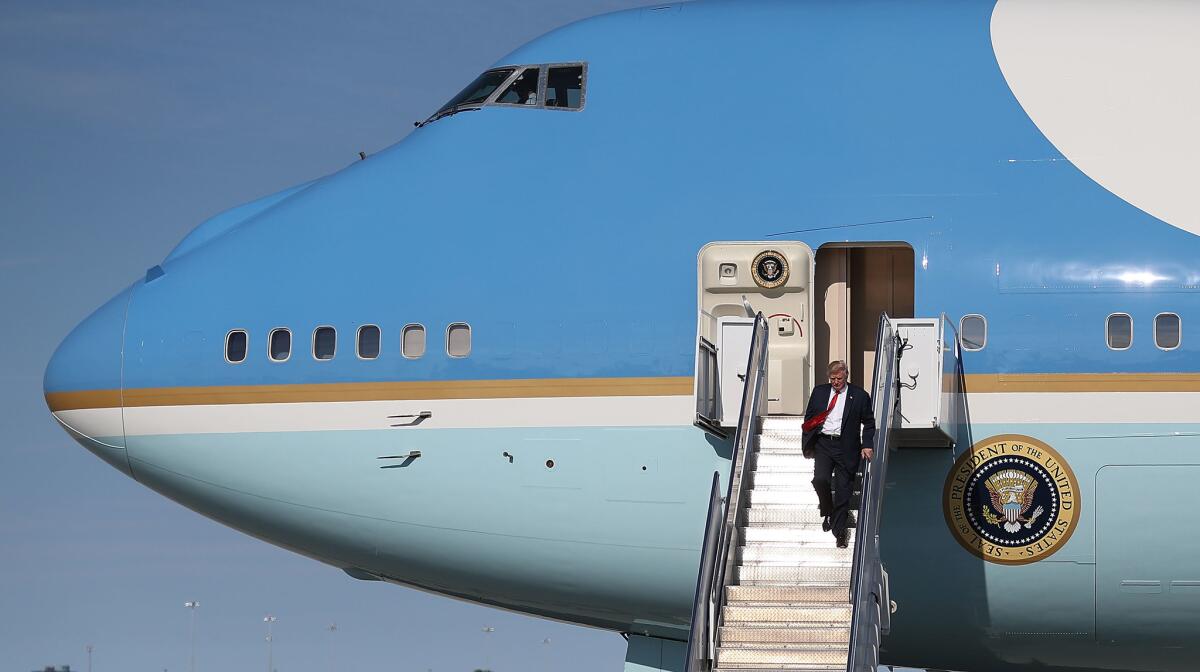South Florida pilots learning that skies are less friendly with airspace restrictions during Trump visits

Reporting from FORT LAUDERDALE, FLA. — Some pilots just aren’t getting the message: They can’t come and go as they please across South Florida’s skies like they used to, at least not when the president is in town.
Since last month, at least 27 aircraft have violated a temporary restriction on the airspace near President Trump’s estate in Palm Beach, federal officials say. And it’s going to take some time and anxious moments for South Florida’s aviation community to get used to it, experts say.
When President George W. Bush visited his ranch south of Dallas at the beginning of his presidency in 2001, there was a learning curve for pilots who “went out flying on a Saturday and didn’t check,” recalls aviation attorney and former U.S. Air Force officer David Norton of Dallas.
If aviators don’t comply, they’ll be stunned to see a fighter pilot hanging off their wing, he said.
“The flying community will get used to it and they need to be careful: It can really catch you off guard,” he said.
With Mar-a-Lago serving as Trump’s winter White House, South Florida faces becoming “real quiet” on weekends for air traffic, said Janet Marnane, a former Navy flight officer during the Cold War.
“These pilots are not used to having so many [restrictions] in this area, but they are going to get used to it real fast,” said Marnane, an assistant professor at Embry-Riddle Aeronautical University in Daytona Beach, Fla. “It is going to be the new normal, but only on the weekends.”
To heighten awareness of the restrictions, the Federal Aviation Administration says it plans to do more outreach to educate local pilots.
The president’s schedule this weekend included a tour of an Orlando Catholic school for a meet-and-greet Friday, before he traveled to Palm Beach, where he was to attend the Republican National Committee spring retreat.
Trump is spending his fourth weekend in South Florida since becoming president; the three prior weekend visits came back-to-back in February.
Each time he visits, pilots within a 30-mile ring around the mansion must abide by the rules — or risk being intercepted by Air Force fighter jets.
During the president’s visits to Mar-a-Lago in February, dozens of local aviators violated the airspace restrictions, including 14 times between Feb. 17 and Feb. 20.
The FAA has declined to release the names of the pilots who violated the airspace restrictions or discuss their cases, citing ongoing investigations.
Pilots violating airspace restrictions might get off with a warning, but presidential-related intrusions likely will lead to a license suspension, Norton said.
Violators, after being forced to land, will “be met by Secret Service and you are going to spend many hours explaining why you were there,” Norton said.
Michael Kucharek, a spokesman for North American Aerospace Defense Command based in Colorado Springs, Colo., said that fighter pilots scrambled to intercept planes in restricted airspace will often try to first get a pilot’s attention with visual hand signals.
If that fails, they’ll “rock the wings,” which means the military jet will fly in front for attention and sway to each side signaling for the pilot to follow.
Another attention-grabbing method: the release of flares that are “essentially dropped in front of the pilot if all these other things don’t work,” he said.
Shooting down a plane “remains an option” although “that would be a very bad day,” he said.
One notable violation occurred last month when two Air Force F-15s hit supersonic speeds to intercept an aircraft, causing a sonic boom that residents heard from Broward to Palm Beach counties.
“I thought it was an actual bomb,” said Coral Springs Mayor Skip Campbell. “The house shook; you felt it vibrate.”
Jets having to reach supersonic speeds, about 750 mph, to intercept a violator is “atypical” and “situationally dependent,” Kucharek said. “We prefer not to go sonic over populated areas. It’s done with the utmost caution so as not to alarm folks on the ground.”
Despite the FAA’s outreach efforts, officials say it’s up to pilots to safely conduct their flights. They’re responsible for checking notices as part of their flight preparations so they’re aware of any presidential-airspace issues that could affect them.
Pilots who hop on their aircraft for no other reason than to “buy a gallon of milk” will need to start checking in to learn of restrictions, said Michael Anthony Punziano, the owner of ATA Flight School in Pembroke Pines south of Palm Beach and a retired Air Force pilot.
“I wish he [Trump] was golfing at Camp David like Obama used to do,” he said.
Huriash writes for the Sun-Sentinel.
ALSO
Citing no evidence, Trump accuses Obama of tapping his phones during the election
Dennis Rodman talks North Korea diplomacy before an audience of cadets at West Point
Trump wants $54 billion more for defense. The military isn’t sure what that means
More to Read
Sign up for Essential California
The most important California stories and recommendations in your inbox every morning.
You may occasionally receive promotional content from the Los Angeles Times.










